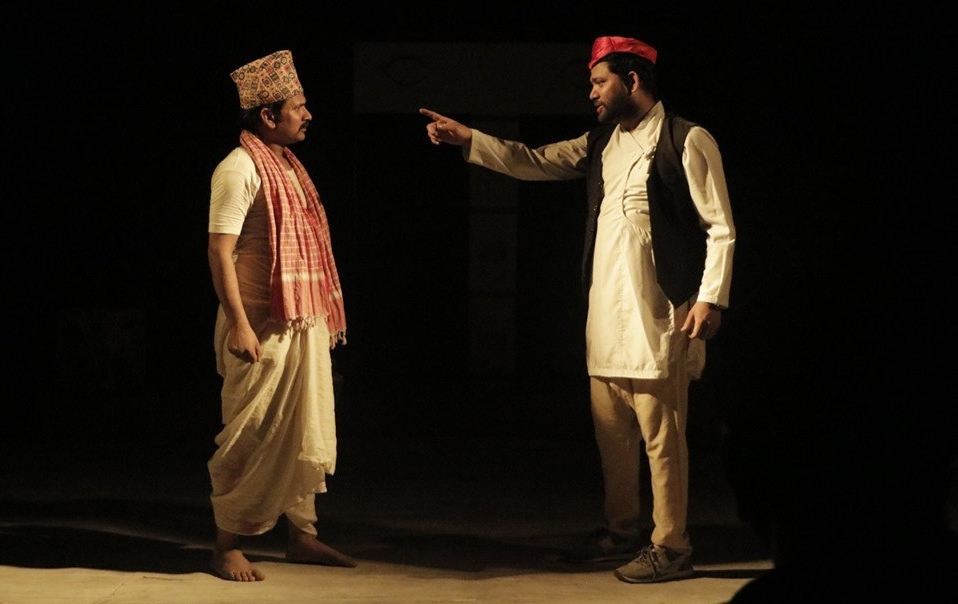Mita, Ab Kona Chalab questions the Madhes-Pahad conflict through the eyes of an innocent, all-encompassing friendship

Sachitra Gurung / Kathmandu: Phoolchand exchanges his pagdi with Dil Bahadur’s dhaka topi, as a promise to be each other’s mit—friends for life. As the ritual proceeds, the priest asks them to exchange one more gift, something precious. Obliging the request, Phoolchand gifts his watch to Dil Bahadur, one that was given to him for his marriage, and Dil Bahadur presents Phoolchand with his beloved radio.
Set against the backdrop of the Madhes movement, Birat Maithil Naatya Kala Parishad’s theatre production Mita, Ab Kona Chalab is a story of two friends—a pahadi and a Madhesi—and how the political chaos of the time affected their families and their friendship.
The play begins with the start of Phoolchand and Dil Bahadur’s unlikely friendship, which begins when the latter helps pull Phoolchand’s oxcart out of a muddy road stretch. Touched by Dil Bahadur’s kindness, Phoolchand asks him to be his ‘mit’. However, because they come from different backgrounds and cultures, Dil Bahadur is hesitant at first but later agrees.
The act of exchanging tokens of their identity—the hats (pagdi, a part of the dhoti-kurta that is worn by Madhesis, and dhaka topi, worn with daura suruwal by pahadis) and their personal possessions—further strengthens their bond, a representation of how they deepen their relationship by acknowledging and accepting each others’ cultures and customs.
One of the highlights of this representation is the presentation of the Chhath festival—primarily observed by the people in the lowland regions of the country—which is joyously celebrated by both Phoolchand’s and Dil Bahadur’s families.
The first half of the play is thus dedicated to building the relationship between the two friends and their families. Then, the stage abruptly goes dark and the sounds of people crying reverberate in the theatre. After a moment’s confusion, it becomes clear that the loud piercing cries are the cries of the people, representing the violence during the Madhes movement.
The changing political landscape of the country influences the youths of the hills and the Tarai region, resulting in rising violent conflict in the Madhes as well. This conflict is represented well through the two characters. From fearing the safety of only one’s family, to their sons being injured, from worrying about each other’s well-being, to insulting each other’s appearance and cultures, the highs and lows of Phoolchand’s and Dil Bahadur’s friendship is emblematic of the struggles of the common people due to the Pahadi-Madhes conflict.
Writer and director Ram Bhajan Kamat, who also plays the character of Phoolchand, has handled the sensitive issue by keeping the plot simple. And by employing excellent acting prowess of his cast—who drive the narrative with gestures and expressions—he has successfully winnowed the raw emotions of two individuals who are themselves in a conflicted relationship due to the ensuing chaos that surrounds them.
A majority of the play is spoken in the Maithali language, with sporadic use of Nepali, but it is not tough for viewers to follow the story, or to empathise with the characters. Except for some abrupt jump-cuts between the scenes, the language barrier is not a problem.
The play also makes judicial use of props, using them only when it adds meaning or helps narrate the story. Throughout the play the background of the stage doesn’t change much either, which could be a conscious decision on the director’s behalf to draw the characters to the foreground. The director also wants his audience to use their imagination while watching the play, as oxen are also played by people.
The simplicity in presenting the idea behind the story is the beauty of the play. As the priest tells Phoolchand and Dil Bahadur in the beginning of the play, during the ‘mit’ ceremony, they have vowed to have each others’ back—in good times and bad. But as the ethnic conflict escalates in their region, the two friends’ state of mind and their handling of relationships symbolise the uncertainty felt by Nepalis everywhere, when violent outbursts consumed the southern part of the country.
One scene that stayed with me, much after the show was over, was when the two main characters decide to reconcile following the suggestions from their wives, and they apologise and embrace each other. But as they stand holding each other, a swarm of people donning devil-horns enter the stage and tear Phoolchand and Dil Bahadur apart from their embrace, showing us how the effects of political divides can unleash on the purest bonds.
The title of the play Mita, Ab Kona Chalab (Friend, where do we go now?) aptly explains the conclusion of the play, and in doing so puts the same question to the audience.
Mita, ab kona chalab is playing everyday except for Mondays at 5:15 pm, and Saturdays at 1.00 pm, at Mandala Theatre, Anamnagar, until May 19. Source: The Kathmandu Post
